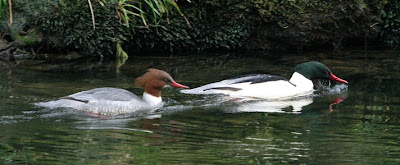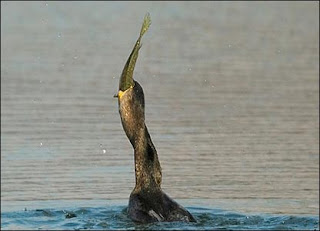Not so long ago this was a scene that you would never have dreamt could happen on a tree lined small tributary but nevertheless it has now become quite a common sight on some of the waters I fish in the Welsh Marches.
I'm aware that these birds have been feeding on our inland waters for many many years, but the concern is that numbers have increased dramatically in the last couple decades to what is now an over-wintering population in the region of 25,000 birds in the UK
An all too familar sight above the rivers of the Welsh marches
The fact that these birds are now feeding in quite substantial numbers on our smaller tributaries will undoubtedly have a severe effect on the future wild fish stocks, these rivers & streams are the spawning grounds for Salmonids and the sanctuary and protection that these streams once offered has now diminished.
A survey by Swansea University found that most fisheries have a problem with Cormorants. Dr Dan Forman, who led the study, said that just eight birds could kill 100 fish in a single session. The birds will return to sites three or four times a day, until stocks are exhausted.
When you consider these facts then you begin to realise how the finely balanced eco-system of these rivers could well be on a road to ruin if left unchecked.
The remains in the stomach of a culled Cormorant

The purpose of this blog entry is to further highlight the problem...I don't confess to having any surefire solutions but I feel that this is potentially a far bigger problem than the likes of DEFRA, Natural England, RSPB and some of the other decision makers even realise.
The non lethal deterrents suggested to help fisheries protect their fish such as underwater refuges, noise generating scarers and automatic scarecrows are extremely difficult to implement on rivers and the existing limits that are licenced to be killed seem to make very little difference.
An amazing sequence of photos captured by amateur photographer Stewart Canham
I would suggest that a big step forward might be for these organisations to consult more closely with angling clubs whose members are encountering first hand the numbers of birds on these rivers and the effect they are having.
Very informative reading on the subject here

















































